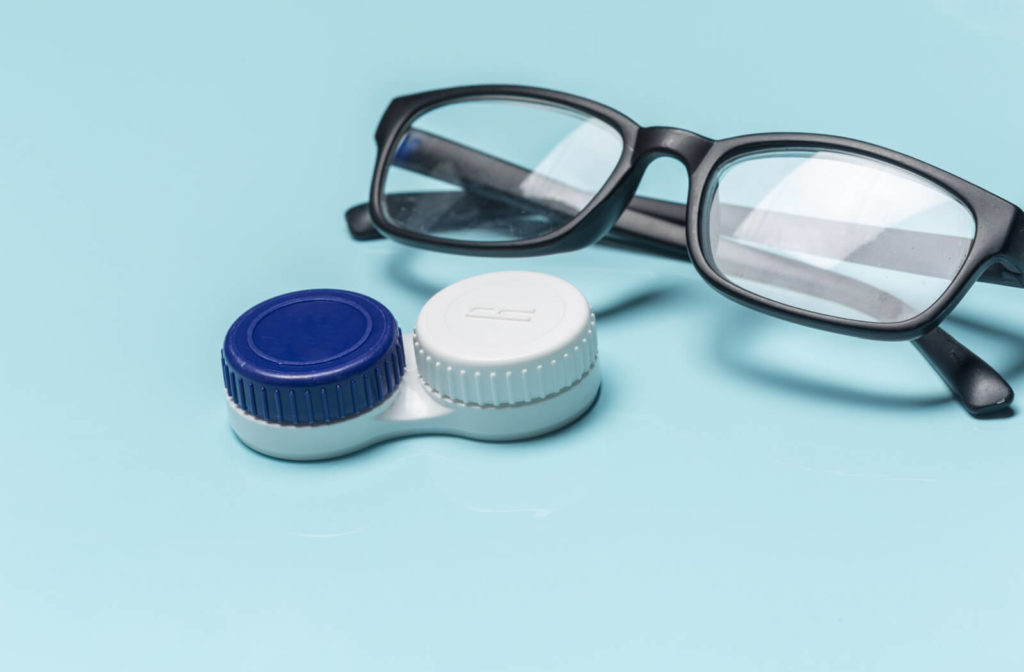Contact lenses and glasses are 2 distinct ways to correct your nearsightedness, farsightedness, or astigmatism and provide clear vision. Many use the 2 methods interchangeably, but the prescriptions are not the same. Contact lens and glasses prescriptions are not the same—they contain different measurements and must be exact to correct vision problems.
If you’re interested in trying contact lenses, you need a contact lens exam and fitting to get an appropriate prescription.
Glasses & Contact Lenses
Wearing glasses or contact lenses is the most common way to correct your vision. Depending on your lifestyle, you may strongly prefer one over the other because they have differences and unique benefits.
Glasses
Eyeglasses lenses are available in 2 primary types: single-vision and multifocal lenses. Single-vision lenses help correct one vision issue and multifocal lenses can help if you struggle to see from multiple distances.
Types of Glasses Lenses
Depending on your age and lifestyle, you may benefit from different lens technology, including:
- High index lenses
- Polycarbonate
- Polarized lenses
- Bifocal lenses
- Progressive lenses
Specialty glasses with a singular purpose can make daily vision problems easier to manage. Computer glasses, which provide ideal magnification if you work at a computer or digital device, can help reduce digital eye strain when you’re at different focusing distances. They can also help prevent dry eye symptoms related to eye strain.
Types of Glasses Lens Coatings
Other features available for your glasses include a variety of coating options, like:
- Transition lenses
- Anti-scratch protection
- Anti-glare lenses
- Blue light lenses
Lens coatings can be a valuable solution for changing light conditions or computer work and help extend the life of your lenses.
Contact Lenses
Contact lenses can be your primary vision correction method or added to a rotation with your glasses to effectively manage your refractive errors.
There are 2 main types of contact lenses: soft and rigid-gas permeable lenses. Soft contact lenses are the most common and are available in different wear options, including:
- Daily wear lenses, where you remove and sanitize them at night
- Daily disposables, where you throw away the pair after each use
- Extended-wear lenses, where you wear them on a schedule your optometrist recommends
There are specialty contact lenses available for atypical eyes, including:
- Scleral lenses
- Toric lenses
- Multifocal lenses
- Ortho-k lenses
Contact lenses require more care than glasses. Your optometrist can review the best methods to sanitize, insert, and remove your lenses at your contact lens exam.

What’s the Difference Between a Glasses & Contact Lens Prescription?
Glasses and contact lenses are distinct vision correction methods. The information on each prescription is different. If you need a prescription, come see an optometrist for an updated prescription.
Glasses Prescription
Your eyeglass prescription has a series of numbers and abbreviations. The headers will read OS (oculus sinister) and OD (oculus dextrus), meaning the left eye, and right eye, respectively. Underneath these headings are numbers indicating the degree of vision correction each eye needs.
These numbers represent diopters, often abbreviated to D. The unit measures the lens’s focusing power or correction.
Figures with a plus sign (+) in front of them signify farsightedness, and a minus sign (-) signifies nearsightedness. The further the number gets from 0, the stronger your corrective prescription will be.
If you have astigmatism, your prescription may have other numbers labeled S, C, and Axis. These abbreviations stand for:
- (S) Spherical: the degree of farsightedness or nearsightedness
- (C) Cylinder: the degree of astigmatism in diopters
- Axis: the orientation of astigmatism and where the astigmatism is present on the eye’s surface
Contact Lens Prescription
Contact lenses rest directly on the cornea (surface of the eye), unlike glasses, which rest in front of your eyes. This detail requires your optometrist to take additional measurements to properly fit contact lenses to the signature curve of your eyes. Your contact lens prescription may include:
- Base curve (BC): measures the back curvature of the lens to comfortably fit the cornea’s steepness or flatness
- Diameter (DIA): measures from one edge of the lens to the other to ensure the lens rests where it should
- Corrective power: the correction of your nearsightedness or farsightedness, which can be different numbers than your eyeglass prescription
- Brand: the recommended brand, material, and lens type based on your preferences, the presence of dry eyes, or other eye conditions
- Expiration date: contact lens prescriptions tend to expire in one year, requiring a comprehensive eye exam to repurchase contact lenses
Update Your Prescriptions
Schedule an appointment to get a comprehensive eye exam and update your glasses and contact lens prescriptions. The team at Total Vision Rancho Bernardo is here to help you see clearly, no matter which vision correction option you choose.



